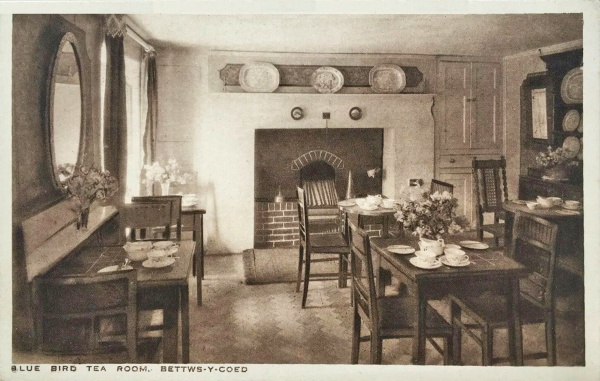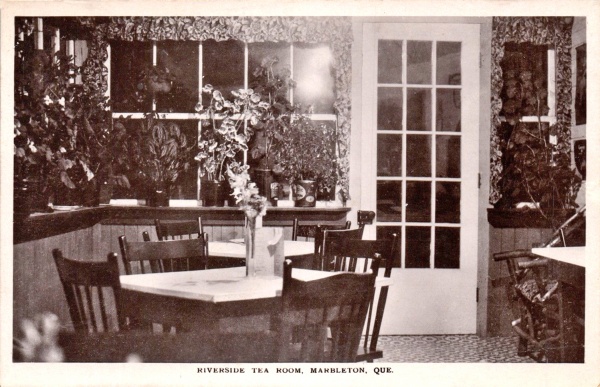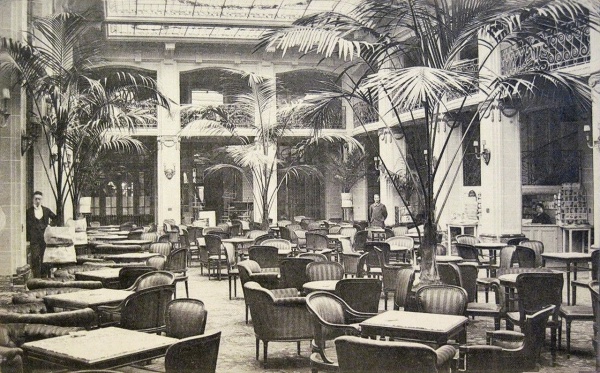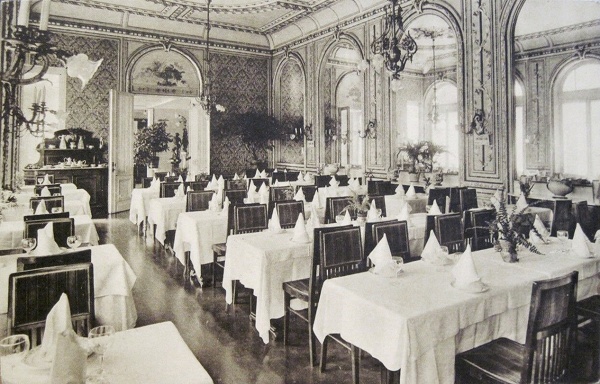The Year of Living Vicariously
From Mystic Tea Room
(→Le Tea Room at Le Grand Hotel in Bruxelles, Belgium) |
(→Le Tea Room at Le Grand Hotel in Bruxelles, Belgium) |
||
| Line 39: | Line 39: | ||
But there's more to see, and all of it reveals the raw newness of this tea room. There are five very large potted palms set about the area, extremely well-grown specimens and no doubt costly to acquire and maintain -- but they are displayed most oddly, with white linen cloths wrapped around their bases. Were the elaborate cache-pots not yet ready? Were the palms still in their burlap root-balls? This is a mystery, for sure, and the maitre de is not telling us the answer. Then we have the odd assortment of furnishings. More than half of the tables are square and set diagonally, in the typical British and American pattern for small tea rooms, except that they are not aligned with the military precision that i expect from viewing dozens of contemporary tea room postcards. Toward the right there are also some circular tables. Did the management not have enough square ones? And then look at the chairs! I count at least four styles -- tall-backed dinner chairs, wood framed arm chairs, a single formal entry-hall chair with upholstered arms, and several low-back upholstered lobby chairs in the French style. The matching coverings of striped damask (typically ivory and dusty rose in colour during this era and in this part of continental Europe) mark the chairs as all belonging to the one hotel -- but not to one single room. | But there's more to see, and all of it reveals the raw newness of this tea room. There are five very large potted palms set about the area, extremely well-grown specimens and no doubt costly to acquire and maintain -- but they are displayed most oddly, with white linen cloths wrapped around their bases. Were the elaborate cache-pots not yet ready? Were the palms still in their burlap root-balls? This is a mystery, for sure, and the maitre de is not telling us the answer. Then we have the odd assortment of furnishings. More than half of the tables are square and set diagonally, in the typical British and American pattern for small tea rooms, except that they are not aligned with the military precision that i expect from viewing dozens of contemporary tea room postcards. Toward the right there are also some circular tables. Did the management not have enough square ones? And then look at the chairs! I count at least four styles -- tall-backed dinner chairs, wood framed arm chairs, a single formal entry-hall chair with upholstered arms, and several low-back upholstered lobby chairs in the French style. The matching coverings of striped damask (typically ivory and dusty rose in colour during this era and in this part of continental Europe) mark the chairs as all belonging to the one hotel -- but not to one single room. | ||
| - | And finally, there are the table cloths, fringed pieces that in a hotel of this quality and in this nation would have been made of fine Belgian linen. In Le Tea Room the tables are not left bare because this luxury space is for hotel guests, not for tourists or motorists. Yet the linens are abbreviated to indicate that Le Tea Room is not a dining room, and so, for comparison, let us look at one of the dining rooms in this same hotel. Here we see a great display of Belgian linen, comprising double-layered table cloths and conical napkins at every place, with setting that include small plates and water glasses as well. Ficus trees in cache-pots and ferns at the tables comprise the botanical decor, and a sideboard holds an array of decorative serving pieces. The beaux-arts plaster-work, metal lamp fixtures, and mirrored | + | And finally, there are the table cloths, fringed pieces that in a hotel of this quality and in this nation would have been made of fine Belgian linen. In Le Tea Room the tables are not left bare because this luxury space is for hotel guests, not for tourists or motorists. Yet the linens are abbreviated to indicate that Le Tea Room is not a dining room, and so, for comparison, let us look at one of the dining rooms in this same hotel. Here we see a great display of Belgian linen, comprising double-layered table cloths and conical napkins at every place, with setting that include small plates and water glasses as well. Ficus trees in cache-pots and ferns at the tables comprise the botanical decor, and a sideboard holds an array of decorative serving pieces. The beaux-arts plaster-work, metal lamp fixtures, and mirrored wall panels are luxurious and in high style for the time. |
[[File:Dining-Room-Grand-Hotel-de-l-Europe-Bruxelles-Brussels-Belgium-postcard-interior-front.jpg|center|thumb|600px|One of several dining rooms at Le Grand Hotel de l'Europe,Bruxelles, Belgium. The formality of the decor, settings, and service ware in the dining room contrasts with the relative informality of the palm court tea room in the same hotel.]] | [[File:Dining-Room-Grand-Hotel-de-l-Europe-Bruxelles-Brussels-Belgium-postcard-interior-front.jpg|center|thumb|600px|One of several dining rooms at Le Grand Hotel de l'Europe,Bruxelles, Belgium. The formality of the decor, settings, and service ware in the dining room contrasts with the relative informality of the palm court tea room in the same hotel.]] | ||
Revision as of 08:16, 28 February 2021
On February 26th, 2020, with the Covid-19 pandemic breaking out all over, my husband and i went into a self-imposed quarantine or lockdown. We decided to order all of our food online, to run our various businesses from home, and to engage with people remotely until such time as a vaccine was developed for the virus. On the one year anniversary of that date, which also happens to be the birthday of my late mother-in-law, who died during the course of this year, i find myself, at 73, still too young to be eligible for the vaccine, and i realize that may be here for months. No one has prioritized vaccinating people such as we, home-based writers, metaphysical merchants, and entrepreneurs.
In this year of living vicariously, i find that i have spent quite a lot of time scanning and uploading postcards of vintage and contemporary tea rooms. Obviously i am missing something in my life and am trying to make up for it. I love the experience of being served tea and treat-foods in cunning little out-of-the-way tea rooms and patisseries with Victorian, Edwardian, Mission, or Craftsman style architecture and furnishings -- but i don't love it enough to die for it.
I began the Year of Living Vicariously by randomly uploading tea room and tea cup images to this site. I went into overdrive in Summer by promising to scan and upload one tea room postcard per day from each of the 50 states and every foreign country for which i could find a card. I made that deadline, and then rested on my laurels, scanning and uploading other subjects of the past, particularly fortune telling postcards.
On January 1st, realizing that i would not be returning to my shop any time soon, i started a Patreon account, as you all well know. Today i have returned to tea rooms for a one-day Patreon upload blow-out.
Unlike my other Patreon pages, which are being held back for one year, these brand-new card-scans will be seen by the public, and the links in each card's caption on this page will lead you to its full-size image on its "home page" at the Mystic Tea Room. However, this article, part of my series "From the Land of Tea," i reserve for my Patrons. It is your support that has made this scan-travaganza possible.
So ... what is it about tea rooms?
I don't usually editorialize about these vintage images. I let them speak for themselves as historic documents. But there are things that stand out, little oddities, flashes of charm and grace, quirky inexplicabilities. Let's take a look:
The Bluebird Tea Room in Bettws-y-Coed, Wales
This is a classic early 20th century British tea room. Like so many of its lovely type, it has a fireplace, and the photographer centers the image on that feature. The display of old dishes or brass utensils is a feature of many such tea rooms, and here we have some large platters on the mantel and a hutch loaded with chinaware at right. There are sweet matched bone china cups and saucers on the tables. The chairs are simple in form and the tables are bare, which is often a sign that we are viewing a tea room, not a formal dining room. The bare table is symbolic of humbleness and casual service, and remains as such in 21st century fast-food restaurants. The botanical decor consists of abundant fresh cut flowers in porcelain vases, a sign that the photo was taken in Spring or Summer, for during the Winter season, we would have had silk flowers, evergreen ivy, or branches of berried holly.

The fact that the proprietor of this tea room, H. Byrd, also ran another tea room in the same small village testifies to the popularity of Bettws-y-Coed as a tourist destination, and the restaurateur's impulse to open a chain of establishments. At the present time, in 2021, i can find no listing for a tea room in Bettws-y-Coed.
The Riverside Tea Room in Marbleton, Quebec
This card depicts a doubly-vanished piece of history. In the first place, it is obviously a back-porch tea room. In the second place, the village in which it existed is no more, being now just a neighborhood of the rather queerly-named village of Dudswell. So let us gaze at the porch-as-tea-room. The out of focus foreground and the glare on the glass window mark this as an amateur snapshot, not the work of a professional photographer. The French door shows a reflection of the room in which the photographer stood.

On the wainscot cap moulding we see a row of tender outdoor plants in tin cans. They are not house-plants, or they would have had cache-pots to add to their decorativeness. No, they are just the home gardener's variegated Pelargonium and Coleus brought in for the winter. Instead of linen table cloths or polished bare wood, the small, square tables, set diagonally, are covered with white butcher paper, an idiosyncratic touch that may indicate the second-hand quality of the finish on the tables.
Le Tea Room at Le Grand Hotel in Bruxelles, Belgium
This is a beautiful example of the hotel palm court tea rooms of 1900 through the outbreak of the First World War. There are so many interesting details in this image! First, although the name of the Hotel is French, the name of the room itself is given in half-English, not Flemish-Dutch, French, or German, the three official languages of Belgium. This is indeed a very grand hotel, with its stained glass atrium skylight and beaux-arts platter festoons. Notice the beautiful wrought iron of the mezzanine balcony, and in the shadows a right, the descending stairs that connect the mezzanine with the tea room floor. But what makes the details of the room most intriguing is that everything seems newly put in place, trembling on the brink of occurrence.
At left we see the maitre d'hotel, with seriousness of purpose expressed in his stance. Just left of center we see the music stands set up for a small orchestral group that will soon be playing for the patrons, but they have not yet arrived. Right of center is the gascon or waiter in his sharp uniform, ready to serve. At far right is the concessioner, a woman who sells magazines and newspapers, with an impromptu table set outside of her alcove, on which are displayed racks of postcards. The postcard craze is in full flower, and this very card will soon join the others she offers, no doubt.

But there's more to see, and all of it reveals the raw newness of this tea room. There are five very large potted palms set about the area, extremely well-grown specimens and no doubt costly to acquire and maintain -- but they are displayed most oddly, with white linen cloths wrapped around their bases. Were the elaborate cache-pots not yet ready? Were the palms still in their burlap root-balls? This is a mystery, for sure, and the maitre de is not telling us the answer. Then we have the odd assortment of furnishings. More than half of the tables are square and set diagonally, in the typical British and American pattern for small tea rooms, except that they are not aligned with the military precision that i expect from viewing dozens of contemporary tea room postcards. Toward the right there are also some circular tables. Did the management not have enough square ones? And then look at the chairs! I count at least four styles -- tall-backed dinner chairs, wood framed arm chairs, a single formal entry-hall chair with upholstered arms, and several low-back upholstered lobby chairs in the French style. The matching coverings of striped damask (typically ivory and dusty rose in colour during this era and in this part of continental Europe) mark the chairs as all belonging to the one hotel -- but not to one single room.
And finally, there are the table cloths, fringed pieces that in a hotel of this quality and in this nation would have been made of fine Belgian linen. In Le Tea Room the tables are not left bare because this luxury space is for hotel guests, not for tourists or motorists. Yet the linens are abbreviated to indicate that Le Tea Room is not a dining room, and so, for comparison, let us look at one of the dining rooms in this same hotel. Here we see a great display of Belgian linen, comprising double-layered table cloths and conical napkins at every place, with setting that include small plates and water glasses as well. Ficus trees in cache-pots and ferns at the tables comprise the botanical decor, and a sideboard holds an array of decorative serving pieces. The beaux-arts plaster-work, metal lamp fixtures, and mirrored wall panels are luxurious and in high style for the time.
On the back of this card we are given the full name of the hotel, Le Grand Hotel de l'Europe, and we learn that it offered convenient access to a casino and a spa. Hotels like this were still to be found during my young years in the 1950s, when i travelled with my mother and step-father to revisit what remained of my mother's remembered youth, before the Nazis despoiled the land and drove her family down to exile or death. We stayed in pensiones, on the cheap, but we visited and dined at quite a few Grand Hotels of which she had fond memories. There was an elegiac quality to them, still peopled by uniformed waiters and outfitted with white linen cloths, but the orchestras were gone, and the palm trees were fewer than she remembered. "They have fallen on hard times," she said, or, ironically, "Well, there goes the glory that was Rome!" I began to collect postcards on this trip, mostly in black and white, and many of them featured restaurant and hotel interiors, due to my love of architecture.
Back home in California, i began collecting postcards seriously, and branched out into linen Main Street views with signage, California agricultural and rural scenes, and a wide variety of auto courts, motels, and roadside attractions from all around the United States. I showed my mother some of my cards, especially those commemorating places that i had seen in person. She became interested in this realization of personal history as well, and vowed to get a postcard from every place she had ever lived or visited -- and she had quite a long list of such places. Along the way, she discovered hotel palm courts, and both of us branched out into collecting them, whether or not we had ever been to those hotels. The internet was taking off and she spent hours buying postcards online. When she died at the age of 90, in 2005, she had an entire box of palm courts and palm-forested hotel lobby postcards, both European and American. My interest spread to tea rooms, but for me, there is always the search for that elusive "double-hit" -- the tea room with palm trees, the palm court tea room.
And now you know why Le Tea Room at Le Grand Hotel de l'Europe is so wonderful to me.





